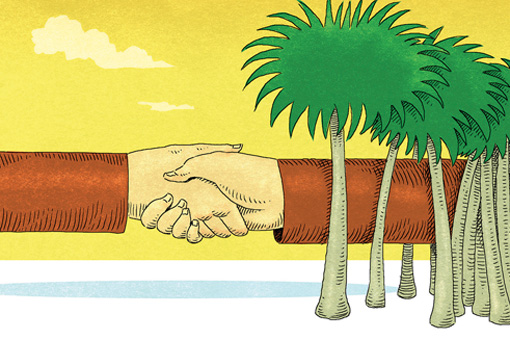After 50 years of armed conflict, the Colombian government and the Fuerzas Armadas Revolucionarias de Colombia (Revolutionary Armed Forces of Colombia—FARC) have an unprecedented opportunity to break with the patterns of violence and underdevelopment that have plagued the country for decades.
The Colombian government had promoted similar peace talks between 1999 and 2002, yet two things distinguish today’s talks: long-term planning that has bolstered the negotiating position of President Juan Manuel Santos’ administration, and the willingness of both sides to be flexible on previously contentious issues like land reform.
The Colombian state’s negotiation strategy dates from the days when Santos was former President Álvaro Uribe’s minister of defense. Even though, ironically, Uribe has become one of the most vocal opponents of the current round of peace talks, the military intelligence mined during his administration (2002–2010) has played a strategic role in designing ongoing talks with the FARC. Now the FARC is pursuing politics as war by other means.
The agreement announced last May by the Colombian government and the FARC on agrarian reform is evidence that the strategy is working. The agreement is not only historic—it’s the first political accord achieved by the two parties in 30 years—but also reflects a substantial shift in the political calculus of both sides.
In a break from their modus operandi, the FARC agreed to pursue agrarian reforms without using revolutionary or violent means. Instead, the document states the need to guarantee land access “with equity and democracy”—in other words, no private property acquired legally will be confiscated. Unlike previous negotiations, this time the FARC is taking a deliberate—and politically wise—step toward pragmatism.
The Colombian government has also taken a more conciliatory tone in the negotiations. In the same land reform agreement, the Santos administration signaled its willingness to address Colombia’s historical underdevelopment and to implement the changes needed to address the social and economic inequalities that have plagued the country, especially in rural areas. The list of pledges contained in the statement announcing the agreement and jointly issued by both parties is long. It includes providing access to land for those people who live in rural areas but have insufficient or no land, technical assistance, education, training, social protection, and the eradication of hunger. Many of these issues were tenets of the FARC’s 1964 agrarian program.
Important concessions were made on both sides of the agrarian reform debate. While the FARC showed flexibility in agreeing not to use revolutionary means, the Santos administration signaled its willingness to integrate the guerrillas—and some of their core ideals—into the nation that emerges from these talks to create the conditions for lasting peace and prevent the resurgence of violence.
And yet, the vocal and public opposition to the peace process with the FARC also suggests the limits and perils of the ongoing conversations. Several opponents, such as former presidents Uribe and Andrés Pastrana, appear worried that Santos will use these negotiations to increase the influence of the Partido Liberal Colombiano. The larger framework of the debate is important to remember. The FARC has been embroiled in a five-decade-long conflict with the government in hopes of overthrowing the state and obtaining power. Agreeing to negotiate a political solution to the conflict means that the FARC finally realized its armed revolution is not attainable.
However, this does not mean that the FARC has given up its political aspirations. In fact, lately it has shown a keen interest in doing politics, something that ought to be welcomed. But with whom will the FARC ally politically?
If the ultimate objective is to have access to power, then the leftist Marcha Patriótica (MP) is not the FARC’s most suitable political vehicle. In fact, MP is not a political party—though as a movement it effectively mobilizes the masses to highlight issues that are important to the FARC. Less useful yet to the FARC is Polo Democrático Alternativo, given their reciprocal mistrust.
Instead, the FARC has been flirting with the Partido Liberal, especially with the faction that includes former Senator Piedad Córdoba and former President Ernesto Samper. In addition, the founders of the FARC were originally Liberal guerrillas during La Violencia, and in 1986, Unión Patriotica in several regions of Colombia was an ally of the Partido Liberal, where it won local elections. Santos has also worked to give prominence and unity back to the Partido Liberal and to further consolidate its influence. In part, that’s why conservatives have accused him of being a traitor.
The real question is whether the negotiations will achieve the ultimate goal: a strong peace agreement that doesn’t just end the conflict with the FARC, but also means a peace in Colombia that overcomes political resentments. Both sides have said that “there is no agreement until everything has been agreed upon.” But if the talks in Havana can establish the conditions under which Colombians come together to build a modern, successful and prosperous democracy, they are worth supporting.





